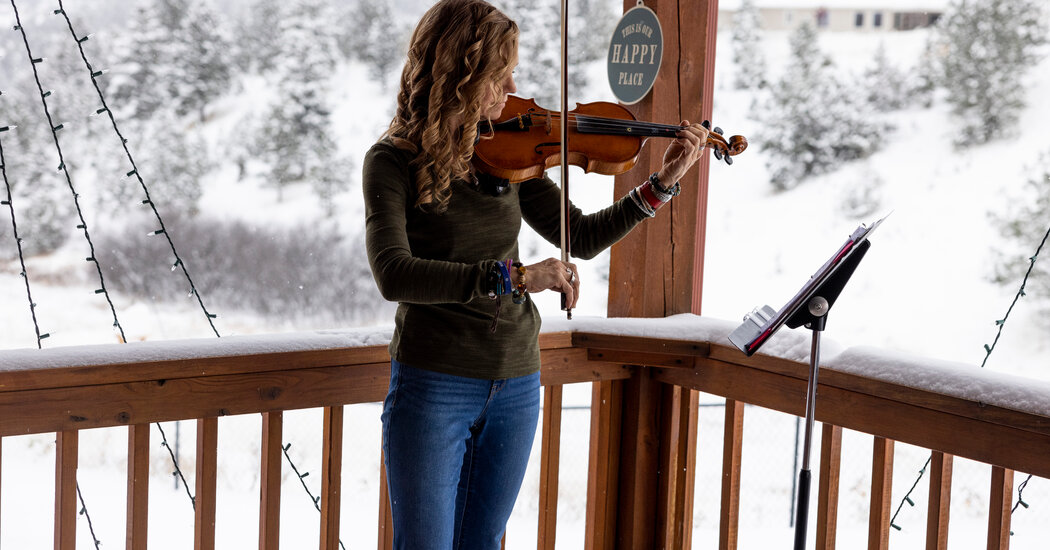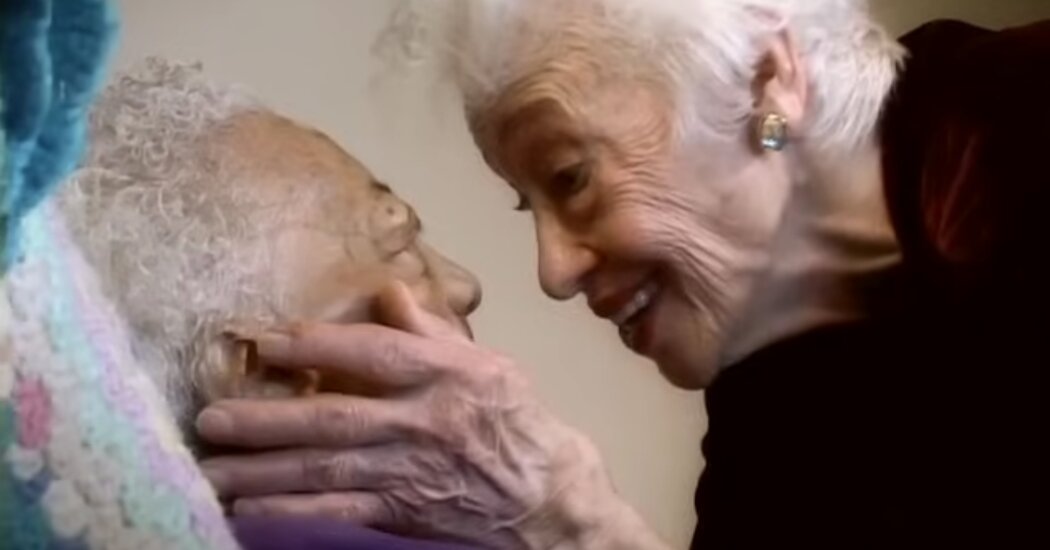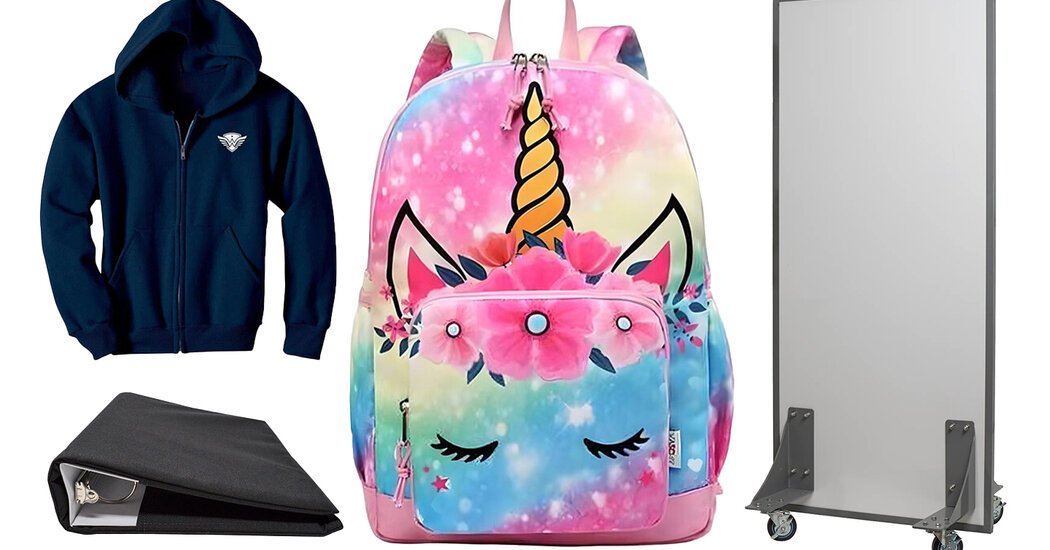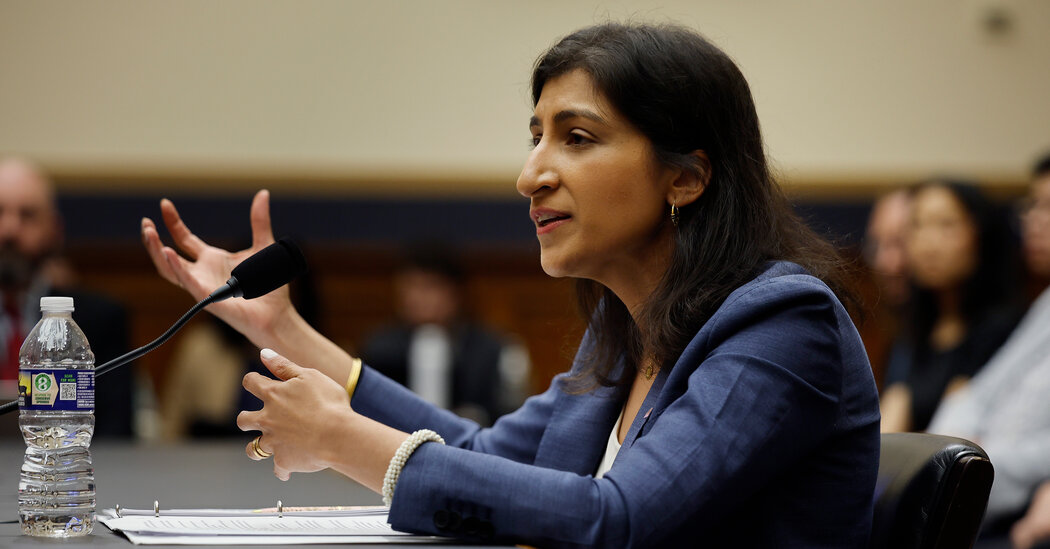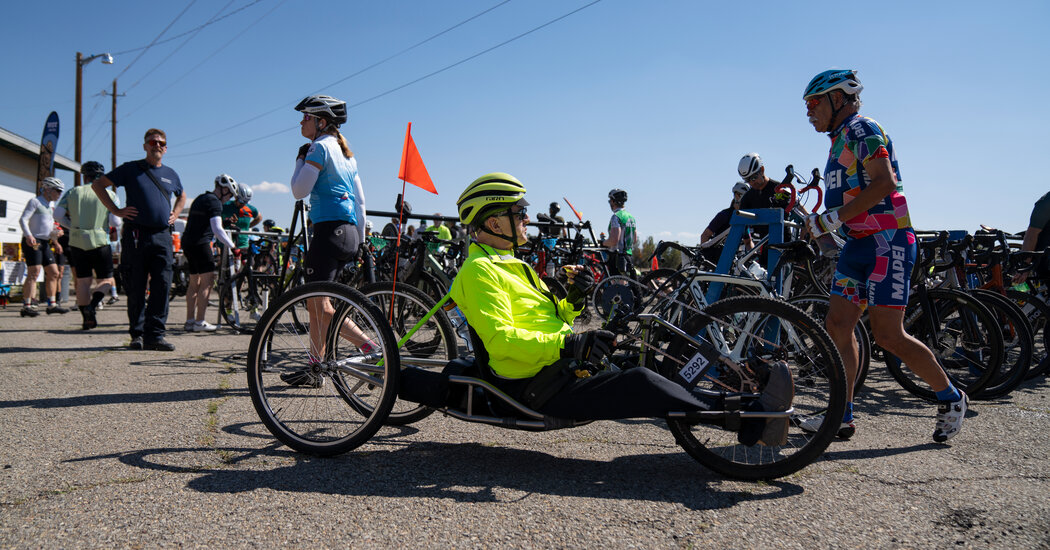On a typical day, Ali Mullen races from her job at the county health department in Helena, Mont., to pick up dinner for her three children, heads home to feed them and then goes back out for a violin lesson or a school play, crisscrossing the small city in her aging S.U.V., with a rainbow bumper sticker that reads “You Are Loved.”
A big pack of gummy bears keeps her going, stashed in her handbag next to a different sort of lifesaver: a gun lock that she carries almost everywhere she goes.
In a sparsely populated state where many people own firearms, the small metal contraptions, which fit around a trigger and cost less than $10 on Amazon, are one way Montanans are trying to reduce the high rate of people who kill themselves.
For the past year, Ali, 46, has been giving gun locks away to anyone who wants one, her piece of trying to solve the puzzle of suicide in Montana.
“It’s in the culture,” she said one afternoon in Helena. “If you don’t know someone, you know of someone who has died.”
Murder rates and mass shootings make national headlines, defining the discussion over pervasive gun violence. But most gun deaths in America are self-inflicted. There were about 27,000 gun suicides in 2022. That was a record, and far higher than the 19,500 gun homicides documented that year.
There have been more gun suicides than gun homicides in the United States every year for the past 25 years. Yet the harm inflicted on communities by suicides rarely registers in the national debate over guns.
Over the past three years, Montana’s typically elevated suicide rate was the highest in the nation, according to an analysis of federal mortality data by The New York Times. In a state of 1.1 million people, 955 people died by suicide from January 2021 through November 2023. Other states in the Mountain West, including Wyoming and New Mexico, have also struggled with high suicide rates and face many of the same challenges as Montana.
Last year, suicides in Montana and the nation declined to near prepandemic levels. But the rate of suicides in Montana remained one of the worst in the country, and a source of widespread grief across the state.
Many of these deaths are felt but not seen. Suicide, despite its frequency, can still be steeped in secrecy and shame. The deaths often come after a struggle with mental health issues or substance abuse.
Suicidal impulses can last only briefly, but easy access to a gun makes the urges more difficult to survive. In Montana, 67 percent of suicides in 2022 involved a gun, according to the Times analysis. Nationally, guns were used in about 55 percent of such deaths.
But in a place where guns are embedded in the rugged, frontier ethos, there is little political will to prevent people who are at risk of harming themselves from owning a gun. A proposal to create a “red flag” law, which would prohibit a person determined to be a danger to himself or others from possessing a firearm, died in a committee of the State Legislature last year.
Several years ago, Ali’s husband’s family passed down some firearms that were considered heirlooms, and she agreed they could be stored at her house.
At the time, suicide did not cross her mind.
***
The first time Ali drove through Montana, she was in college on a road trip in the late 1990s. She remembers how the clouds cast giant shadows on the open plains, revealing the state’s “Big Sky.”
She was hooked.
She transferred to the University of Montana from a college in Illinois. After graduation, she worked as a 911 dispatcher in Glacier National Park, fielding calls for “bear-jams,” when traffic would stop because a grizzly wandered out into the middle of the road.
John Mullen was working as a handyman at what is now the Whitefish Mountain Resort when they met.
They married in Glacier. A pair of bald eagles circled overhead as they exchanged their vows. “It’s the greatest place on earth,” she said of Glacier.
After their first child, a daughter, was born in 2006, they moved to the Helena area to be closer to John’s parents.
The vice president of a community bank took a liking to John and hired him as mortgage loan officer. He was a natural, tapping his connections across greater Helena where he had lived since he was a boy.
Montana is a vast state. Yet, somehow, Ali said, it could feel intimate.
“Montana is a string of small towns connected by one or two highways,” she said. “We all know each other.”
But that closeness can also amplify the fallout from suicides.
Research has shown that 135 people can be “exposed” to a single suicide and that some of those closest to the person who dies can be at greater risk of contemplating suicide themselves.
“There is a lot of strength in a small-town structure, but the downside is that if you lose one person to suicide, it can have a large impact on the community,” said Janet Lindow, chief executive of the Rural Behavioral Health Institute in Livingston, Mont., which screens children for suicide risk and connects them with mental health care.
Researchers say numerous issues contribute to Montana’s suicide problem. A report by the state’s suicide prevention coordinator points to a combination of factors, including access to firearms, the isolation of rural living and the relatively large number of veterans and Native Americans in Montana, groups that have had higher rates of suicides.
The Rev. Keith Johnson, the pastor of the Life Covenant Church in Helena and a friend of Ali’s, used to avoid talking openly with congregants about suicide.
But faced with such regular deaths in the community, he now talks about the issue with middle school and high school students at his church, which is not far from the State Capitol building and blocks of Victorian homes, some dating back to Helena’s boom during the gold rush.
If you are having thoughts of suicide, call or text 988 to reach the 988 Suicide and Crisis Lifeline or go to SpeakingOfSuicide.com/resources for a list of additional resources. Go here for resources outside the United States.
“I have known people who have taken their life, who were followers of Jesus Christ,” Mr. Johnson said. “In my opinion, while it can be related to a spiritual issue, it needs to be understood as a mental health issue.”
For years, John struggled with his mental health and Ali begged him to see a therapist, but he resisted. “I think it was very hard for him to admit that he was struggling,” she said.
Just before the lockdowns began in March 2020, John had started a new job at a mortgage company. Ali obtained her brokerage license and joined him at the company. They worked at desks crammed together in their bedroom in their house in Clancy, a small town near Helena.
As 2020 wore on, John increasingly found himself at odds with some people around town. He got into shouting matches with people who refused to wear masks and those who questioned whether Covid was real, his wife said.
John experienced volatile mood swings, which weighed on the family, Ali said. He started keeping the shades in their house drawn. He stopped going out with friends for beers. He fixated on conspiracy theories circulating online about social unrest.
His former boss and mentor at the bank, Jim Smith, remembers hearing John’s voice breaking when he talked about the Jan. 6, 2021, attack on the U.S. Capitol. “He said, ‘Where is the country going for my kids?’” Mr. Smith recalled.
After the attack, Ali noticed that her husband started having trouble sleeping. “Something changed in him after that.”
***
One condition Ali had for bringing guns into her house was that they had to be locked up to keep them safe from their children.
One Christmas, when her children were still little, she bought a safe from a Helena gun shop for $100 and put it under the tree.
Ali and John kept the keys in a place only they knew about. But Ali eventually realized that her husband was the one who needed protecting.
When his mood would darken, she would secretly take the keys and keep them in her pocket. Then the storm would pass, and she would put the keys back in their original hiding spot.
She did not think to hide the keys again when her husband started shredding papers and told her the password to his phone. She was overwhelmed by her own stresses from the pandemic — the family’s health, remote school, her new job as a mortgage broker.
She knew her husband was struggling, but she didn’t comprehend the depth of his desperation. She knew that a friend of his had fatally shot himself. But she was not aware of how that death might affect John.
On the evening of Jan. 20, 2021, the family had finished dinner when John walked outside with a gun.
Ali realized what was happening and followed him out into the yard. By the time the paramedics arrived, she knew that her husband wouldn’t survive.
Ali fell to the ground. A deputy sheriff helped her up. Then she went inside and told her three children what had happened.
***
The year John Mullen died, at age 40, Montana was among the nation’s fastest growing states.
Ultrawealthy second-home owners and people wanting an escape from mask and vaccine mandates elsewhere all came seeking their piece of the “Last Best Place,” as Montana is known.
Ali considered moving out of the house where her husband died. But with so many people relocating to Montana, it was difficult to find an affordable home for sale.
She felt trapped. People she barely knew would stop her in Costco to ask how she was doing. Grocery clerks would start crying when she walked in the store. Despite this sympathy, “I felt utterly alone,” she said. “Like I was the only person in Helena that this had happened to.”
In the spring of 2022, Ali realized she was far from the only one.
She joined a newly organized group called the LOSS team, which stands for Local Outreach to Suicide Survivors and which supports people whose loved ones have died by suicide. The first such team was started in Louisiana in the late 1990s, and there are organizations now operating in numerous states, including in Lewis and Clark County where Helena is.
As part of the team’s outreach, a survivor and a mental health professional visit a home in the days after a death has occurred.
Seeing a survivor who is “dressed” and “functioning” after experiencing a loss “plants seeds of hope” in the newly bereaved, according to the LOSS team website.
When Ali attended her first meeting, she realized the scale of the suicide problem. “I had never seen so many survivors in one place” she said.
She met Rowan Rankin, who with her best friend started a group called Saving Helena High School because they wanted to raise awareness about the student suicides there.
Ms. Rankin, who graduated from the high school in 2016 and now works as a care coordinator at the Helena children’s hospital, said, “gun ownership is an important part of many Montanans’ lives and that isn’t going to change.” But she believes that “learning to safely store lethal means” can help prevent gun suicides.
Another LOSS team member, Julie Madden, said there needed to be more ways to keep guns away from people who are struggling with mental illness. Ms. Madden’s son Tim died by suicide in April 2021. He had spent his childhood summers in Montana, hiking, camping and target shooting at his family’s remote cabin.
When Mr. Madden died, he was living outside of Houston. A musician, he had been hospitalized several times for various mental health crises during his life.
There are no state laws in Texas or Montana that require a waiting period for completing a gun purchase.
Mr. Madden used his pandemic stimulus money to purchase the gun he used to take his life at age 35. It was the first firearm he had ever owned.
“Some people get angry at God for letting things like this happen,” said Ms. Madden, who is 73. “I am a realist. I know bad things happen to innocent people.”
“I am angry at the states that allow people with a record of hospitalizations to buy a gun.”
“But I am not ready to be a crusader yet,” she added. “I am still looking at my son’s boxes that I need to go through and I think, ‘Maybe another day.’”
***
Last April, the Legislature in Montana passed a piece of bipartisan legislation that would make it easier for people worried about their own mental health to temporarily store their guns with a friend or family member.
The new measure shields the person who agrees to hold the guns from liability if anyone is harmed after the firearms are returned to their owner.
“It is no great shakes, but if you look at the bigger picture in Montana, it’s a big stride forward,” said Mary Ann Dunwell, a Democratic state senator and a sponsor of the bill.
She is part of a bipartisan group of about 20 lawmakers who are discussing additional proposals ahead of the next legislative session to further increase safe gun storage.
Anything more aggressive on guns faces long political odds in the State Legislature, where Republicans hold majorities in the House and Senate and where there is deep support for gun rights.
Ms. Dunwell said that there was widespread concern about being perceived as anti-firearm in Montana, and that it was stifling discussions about guns.
Last year, Montana enacted a law requiring certain businesses receiving state funds to sign a contract stipulating that they would not “discriminate” against a “firearm entity” or “firearm trade association.”
“I have Democratic colleagues who are afraid to introduce bills for firearm safety because of the political repercussions,” Ms. Dunwell said.
Last year, Ali was hired by the Lewis and Clark County Public Health Department to work on issues around addiction and suicide prevention. Her work focuses on gun safety, as well as on safe storage and disposal of medicine to prevent suicides from overdoses.
She knows from experience that gun safes and trigger locks are not perfect solutions. Gun owners are encouraged to take the extra step of giving the keys to a friend or even freezing the keys in an ice-cube tray. Anything that can slow a suicidal impulse can save a life.
After her husband died, Ali had all the guns removed from her house. But she doesn’t think it is productive for suicide prevention efforts to push for gun restrictions. “People don’t want to be yelled at,” she said.
***
Ali has also taught her three children a series of “protective barriers” to keep them safe from suicide.
If they experience anxiety, they have steps to get “grounded” again. When they feel lonely, they need to call a friend.
Ali’s daughter, Nora, was a member of the National Honor Society this year and starred in the school musical at Helena High School. In the fall, Nora is headed to the University of Montana to study biology. Ali’s two sons earned straight A’s this year.
A big source of support and inspiration at Helena High School had been a science teacher and trusted counselor for students in crisis named David McKim.
One day in early November, Ali was at work when Nora called and “could barely speak,” Ali recalled.
Mr. McKim had taken his life.
She raced over to the school to pick up her daughter and son and any other students who wanted to join them.
A group of them hunkered down at the Mullens’ house. They baked cookies and watched cartoons. One boy stayed for four days.
Even in a small city of about 34,000 people that is accustomed to suicide, Mr. McKim’s death shook the community.
Ali attended Mr. McKim’s memorial service in a school gym in Helena. The mayor of Helena was there, alongside hundreds of students, parents and teachers.
Ms. Rankin from the LOSS team was there, too. Mr. McKim had been a big supporter of her “Saving Helena High School” initiative after a rash of student suicides.
Ali’s friend Pastor Johnson presided over the service. He was Mr. McKim’s pastor and close friend.
Some of the speakers at the service were open about Mr. McKim’s challenges with mental health, a candor that was seen by many as a step toward raising awareness about the issue.
Before his death, Mr. McKim had been treated for anxiety and was given a medication that could cause suicidal ideation if mixed with alcohol, his brother Andy said in an interview. Mr. McKim died from a self-inflicted gunshot wound.
While Mr. McKim, 49, was struggling with his mental health, he had handed over his guns to be stored outside his home, his brother said. But at least one gun was still in the house. Andy said he thought that his brother kept that gun for protection or had forgotten to hand it over for safekeeping.
Mr. McKim used to talk for hours with Andy about the anguish he felt over the student suicides. “In my heart, I know when he was in his right mind, suicide wasn’t something he would have considered,” Andy said.
During the service in the gym, Ali saw the fresh grief on many students’ faces. She handed out pamphlets to parents about spotting warning signs in teens. She insisted some students take cards with the suicide hotline number printed on it.
She listened to stories about Mr. McKim, a devoted teacher and avid outdoorsman, who loved Montana. Like her husband had.
A former colleague of Mr. McKim’s quoted from a book by the Montana-raised writer Norman Maclean:
“Eventually all things merge into one, and a river runs through it.
“The river was cut by the world’s great flood and runs over rocks from the basement of time. On some of the rocks are timeless raindrops. Under the rocks are the words, and some of the words are theirs.”
Eli Murray and Susan Shain contributed reporting. Kirsten Noyes contributed research.



